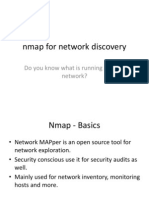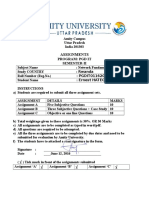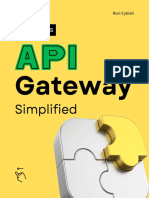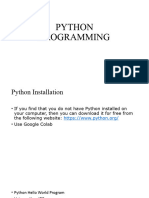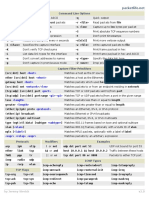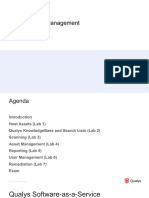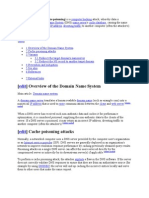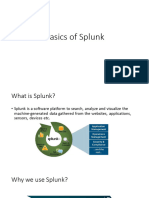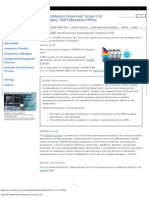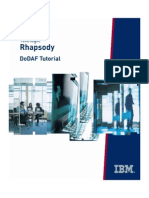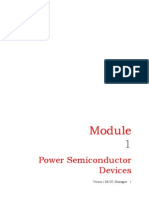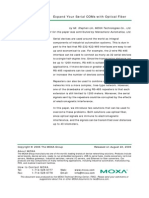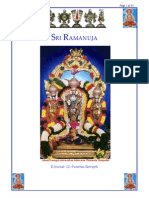Advanced Nmap Command Line Options
Advanced Nmap Command Line Options
Uploaded by
ksenthil77Copyright:
Available Formats
Advanced Nmap Command Line Options
Advanced Nmap Command Line Options
Uploaded by
ksenthil77Original Description:
Copyright
Available Formats
Share this document
Did you find this document useful?
Is this content inappropriate?
Copyright:
Available Formats
Advanced Nmap Command Line Options
Advanced Nmap Command Line Options
Uploaded by
ksenthil77Copyright:
Available Formats
Write For Us
Submit Tips
Subscribe to Print Edition
Contact Us
Search
HOME
REVIEWS
HOW-TOS
CODING
INTERVIEWS
FEATURES
OVERVIEW
BLOGS
SERIES
IT ADMIN
Advanced Nmap: A Recap
By Rajesh Deodhar on May 1, 2011 in How-Tos, Sysadmins, Tools / Apps 0 Comments
Search for:
Search
Get Connected RSS Feed Twitter
This final article in the series consolidates information from the previous articles, looks at NMaps future possibilities, and at the new tools from the development team.
Beginning its life as a simple port-scanner, Nmap has evolved into an excellent network security auditing tool. The Nmap website now describes it as a free and open source utility for network exploration or security auditing. Like most open source utilities, Nmap is released under the GNU GPL license (free to use, modify, and distribute). Interested users can download the latest version for their OS and start using it. All versions have the same command-line syntax and the same GUI; the only differentiator is a persons knowledge of how to use it to scan/audit the network. Understanding the various command-line options should help you use the tool in the most effective way. For example, while demonstrating the Nmap Scripting Engine capabilities at Black Hat 2010, the following steps were performed live: 1. Tracking a live Web cam installed on an unknown public IP. 2. Brute-forcing its username/password to gain access. 3. Watching the live video displayed. The seemingly impossible feat was performed in less than 15 minutes. Sure, it is definitely not easy to achieve this kind of expertise, but to effectively master Nmap for everyday use should not be too difficult.
Nmap command-line options
If you run n m a pwithout any switches, it gives you a list of all available command-line options. These are logically classified as shown in Table 1. Table 1: A summary of NMap commands Scan switch Target specification Utilisation You can specify the target in various intuitive ways: by directly specifying the hostname/IP address; or by giving the start and end addresses to specify a range. You can also pass a list of IP addresses to Nmap using the
i Lswitch, followed by the name of the file containing the IP list. You may
also exclude hosts with the e x c l u d e< h o s t n a m e ( s ) >switch. Host discovery From a wide range of hosts to be scanned, you will probably be interested in finding specific hosts, depending on the reason for the scan. Nmap has various host-discovery techniques; some of the important ones are:
s L , which will list the hosts to be scanned, but wont perform an actual
LINUX For You on
Follow
+2,530
scan.
P S , which will perform a TCP SYN scan by sending a SYN packet to the
Find us on Facebook
destination host, by default, on port 80. If an RST is received, it indicates a closed port. No reply indicates a filtered port, and an ACK response indicates an open port Similarly, P A(ACK ping), P R(ARP ping), P U(UDP Ping) are also available. While scanning internal networks, in particular, the noption that disables the DNS resolution of IP addresses, may come in handy. Scan techniques Nmap supports various scan techniques: s Sfor a SYN scan; s Pfor a ping scan; s Ufor a UDP scan; bfor an FTP Bounce scan; and s Ifor an idle scan, using a zombie host. By default, Nmap scans the 1,000 most common service ports. The t o p p o r t s nswitch overrides this default setting with n . The Fswitch reduces the most common scanned ports to 100. The following option is very useful if only predetermined ports are required to be scanned: p
U : p o r t n u m b e r sT : p o r t n u m b e r s
Open Source For You
Like 256,371 people like Open Source For You.
F acebook social plugin
Port specifications
Popular
Comments
Tag cloud
August 13, 2013 46 Comments Diksha P Gupta
India has immense under-utilised talent in the cloud security space
June 20, 2013 5 Comments sophie-samuel
Service/version detection
When services are running on non-standard ports, a version detection scan (s V ) on that particular port may provide an excellent option to detect what service it is. To run this scan on all ports, use a l l p o r t s . As mentioned on nmap.org, NSE is Nmaps most powerful and flexible feature. Users can write scripts in the Lua programming language for automated scanning. Nmap version 5.50 has 177 ready-made NSE scripts in various categories, including discovery, DoS exploits, version-detection and a few more. Some of the intrusive category scripts may crash the target system or use up significant resources on the host.
New and amazing features of Linux
June 20, 2013 3 Comments Priyanka Sarkar
Script scan
What it Takes to be an Open Source Expert
August 24, 2013 3 Comments Priyanka Sarkar
Secure Your Career with Ethical Hacking!
August 24, 2013 0 Comments Shashwat Pant
Get Fit With Android
Operating system detection Timings
The Ooption does operating system fingerprinting. Nmap version 5.50 has 2,982 OS fingerprints and 7,319 version-detection signatures.
Though often neglected, adjusting scan time is very important in effective network scanning. Consider two scenarios: When scanning a large number of hosts, fine-tuning scan timing is essential. For example, scanning a Class B IP address range (up to 65,535 addresses) may require significant time. The possible options to use here are: m i n r t t t i m e o u t ,m a x r t t t i m e o u tand h o s t t i m e o u t . To scan devices deployed with IDS/IPS, only a few probes may be allowed in a certain interval; s c a n d e l a ymay be used here.
Firewall/IDS evasion and spoofing Output
fdoes fragmentation; Di p _ l i s tsets up decoy hosts. S i p _ a d d r e s s e sdoes spoofing of source IP address, while s o u r c e p o r t p o r t n u m b e rspoofs source port numbers.
Three basic output options are available: o Nfor normal output, o Xfor XML output, and o Gfor g r e p pable output. The o Aoption provides output in all the above formats. One more important option is verbosity. While a scan is running, you may press v to increase verbosity and V (Shift+v) to decrease it. The most important is 6 , which enables IPv6 scanning.
Miscellaneous
Nmap uses various files to store its default options. Users may edit these files to fine-tune options for individual scanning requirements. From the exhaustive list above, a few options that come in really handy while scanning networks are shown in Table 2.
Table 2: Interesting NMap options Option
s Cs m b u s e r s e n u m s Cs m b s h a r e s e n u m
Description Really handy for scanning SMB networks, these options respectively return a list of users, and a list of shares detected in the specified host range. Detects operating systems even of various networking devices. Runs a standard scan, including OS version detection Speeds up the scan; especially useful in quickly scanning a range of IP addresses. Ping response is disabled on a few hosts to be scanned. This option assumes the hosts are up/online.
A T 4
P N(or P 0 )
Other tools
The Nmap team is also developing some other very interesting tools, some of which follow: ncrack Network authentication cracking tool, includes support for cracking RDP, SSH, HTTP, HTTPS, SMB, POP3, POP3S, FTP, and telnet. ncat Reads and writes data across networks from the command line (similar to netcat) zenmap GUI for Nmap ndiff Compares and shows differences in two Nmap scan result files nping Network packet generation, response analysis and response time measurement tool. Includes echo mode, debugging with sent/received packets, captured packets on the server, etc. rainmap An online scanning service With this, I conclude this series on NMap.
References
NMap Network Scanning book by Gordon Fyodor Lyon Various NMap site links: Homepage, Download, NSE Documentation, Rainmap Documentation The Lua programming language (used for NSE programming) insecure.org
Feature image courtesy: Alpha six. Reused under the terms of CC-BY-SA 2.0 License.
Related Posts:
Advanced Nmap: Scanning Techniques Continued Advanced Nmap: FIN Scan & OS Detection Advanced Nmap: Scanning Firewalls Continued Advanced NMap: Some Scan Types Advanced Nmap: NMap Script Scanning
Tags: Advanced Nmap Series, black hat, DNS, DOS, firewall, Gordon "Fyodor" Lyon, GPL, internal networks, IP, IP addresses, IPV6, LFY May 2011, Lua, network exploration, network security, NMap, NSE, online scanning service, operating systems, port scan, port scanner, Security, security auditing, UDP, xml
Article written by:
Rajesh Deodhar
The author is BE (Industrial Electronics), CISA (Certified Information Systems Auditor) and DCL (Diploma in Cyber Law). He has more than 15 years of experience in the field of computer hardware, networking, firewalls and IS auditing. He is a director at Omega Systems and Services, Pune. Connect with him: Website
Previous Post
Next Post
Securing Database Servers
The Quick Guide to QEMU Setup
AROUND THE WEB
ALSO ON LINUX FOR YOU
What's this?
Billionaires Dump Stocks, Prepare for Collapse Moneynews Don't Get Alzheimer's: Here's What May Cause It Newsmax Health Don't Let Your Kids Read This: Paying Teens for Citi Women & Co. Watch what you say when you're not talking Kelly OCG
India has immense under-utilised talent in the cloud 46 comments Secure Your Career with Ethical Hacking! 3 comments Cyber Attacks Explained: The Botnet Army 1 comment GNOME Extensions Spicing Up the Desktop Experience 1 comment
0 comments Leave a message...
Newest Community Share
No one has commented yet.
C o m m e n t fe e d
Su b s cri b e vi a e m a i l
Reviews
How-Tos
Coding
Interviews
Features
Overview
Blogs
Search
Popular tags
Linux , ubuntu, Java, MySQL, Google, python, Fedora, Android, PHP, C, html, w eb applications , India, Microsoft, unix , Window s , Red Hat, Oracle, Security , Apache, xml, LFY April 2012, FOSS, GNOME, http, JavaScript, LFY June 2011, open source, RAM, operating systems
For You & Me Developers Sysadmins Open Gurus CXOs Columns
All published articles are released under Creative Commons Attribution-NonCommercial 3.0 Unported License, unless otherw ise noted. LINUX For You is pow ered by WordPress, w hich gladly sits on top of a CentOS-based LEMP stack.
You might also like
- Exercise TLSDocument12 pagesExercise TLSdjamiagapeNo ratings yet
- Subrahmanya Bhujanga Stotram Eng v1Document4 pagesSubrahmanya Bhujanga Stotram Eng v1ksenthil77No ratings yet
- Don Bosco Study Guide 1 PDFDocument11 pagesDon Bosco Study Guide 1 PDFUniversidad Don Bosco100% (1)
- Application Under Section 476Document2 pagesApplication Under Section 476Asad Saeed100% (5)
- 3 NmapDocument6 pages3 NmapJohn WickNo ratings yet
- Configuring IPCop Firewalls: Closing Borders with Open SourceFrom EverandConfiguring IPCop Firewalls: Closing Borders with Open SourceNo ratings yet
- Nmap For Network DiscoveryDocument14 pagesNmap For Network DiscoveryakashmahajanNo ratings yet
- How SSL WorksDocument9 pagesHow SSL WorkskiranNo ratings yet
- 10 Practical Nmap CommandsDocument2 pages10 Practical Nmap CommandsB.JayNo ratings yet
- TCP Scanning Using NmapDocument12 pagesTCP Scanning Using Nmapprat jariwalaNo ratings yet
- Chapter 9: Transport Layer: Instructor MaterialsDocument50 pagesChapter 9: Transport Layer: Instructor MaterialsEko WiyandiNo ratings yet
- Networking Fundamentals AssignmentDocument10 pagesNetworking Fundamentals AssignmentHategekimana ErnestNo ratings yet
- Explain: Assignment-1Document4 pagesExplain: Assignment-1Nikhil AggarwalNo ratings yet
- Module 02 - Footprinting and Reconnaissance - Lab 2 - Perform Footprinting Through Web ServicesDocument26 pagesModule 02 - Footprinting and Reconnaissance - Lab 2 - Perform Footprinting Through Web Serviceskaka shipaiNo ratings yet
- API Gateway 1690125116Document10 pagesAPI Gateway 1690125116LisangolaNo ratings yet
- (v2022.9) Burp Suite - Leading Software For Web Security Testing - AppNee Freeware GroupDocument5 pages(v2022.9) Burp Suite - Leading Software For Web Security Testing - AppNee Freeware GroupAjay MaluNo ratings yet
- Assignment OF CSE-213Document8 pagesAssignment OF CSE-213shonatajNo ratings yet
- VAPT Lab Assignment 4Document12 pagesVAPT Lab Assignment 4Abhishek HajareNo ratings yet
- 6CS4-23 Python Lab PlanDocument2 pages6CS4-23 Python Lab PlanRishab MalikNo ratings yet
- Data Communication &networks: Domain Name SystemDocument20 pagesData Communication &networks: Domain Name Systemghulam mustafaNo ratings yet
- Python ProgrammingDocument142 pagesPython Programmingshahrukhkr.gptNo ratings yet
- Tap Proof EncryptionDocument8 pagesTap Proof EncryptionLightwave LabNo ratings yet
- Take Your Cyber Security Career To The Next Level 1595478442Document11 pagesTake Your Cyber Security Career To The Next Level 1595478442Florick Le MahamatNo ratings yet
- CS GTU Study Material Presentations Unit-1 02102020082427AMDocument63 pagesCS GTU Study Material Presentations Unit-1 02102020082427AMachyutdobaria0412No ratings yet
- Print Formatting in PythonDocument3 pagesPrint Formatting in PythonJai KrishnaNo ratings yet
- CSA Preparing The IR Toolkit + Chpt9Document43 pagesCSA Preparing The IR Toolkit + Chpt9RammyBradNo ratings yet
- Go101-V1 12 C 6 Print PDFDocument514 pagesGo101-V1 12 C 6 Print PDFgeekfighterNo ratings yet
- As Assignment 2Document16 pagesAs Assignment 2ASHNA CHOUDHARY 20BCI0158No ratings yet
- CS45-TCP Course NotesDocument25 pagesCS45-TCP Course NotesfalconNo ratings yet
- 10 Python NetworkingDocument15 pages10 Python NetworkingYA uzNo ratings yet
- Static and Dynamic TestingDocument13 pagesStatic and Dynamic TestingAshish YadavNo ratings yet
- Computer Security: Principles and PracticeDocument36 pagesComputer Security: Principles and Practicemuhammad waseemNo ratings yet
- Assignment No.5 Question No.1:: What Is The Difference Between A Block Cipher and A Stream Cipher? AnswerDocument2 pagesAssignment No.5 Question No.1:: What Is The Difference Between A Block Cipher and A Stream Cipher? Answersameer khanNo ratings yet
- BASH Programming 50 QuestionsDocument14 pagesBASH Programming 50 QuestionsMartin De La MoraNo ratings yet
- File InclusionDocument73 pagesFile Inclusiontemporeda487No ratings yet
- Apache Security and AttacksDocument36 pagesApache Security and Attackshatim44026No ratings yet
- Ana Chanaba Robert HuyloDocument18 pagesAna Chanaba Robert HuyloAkshay ChoudharyNo ratings yet
- Functions in PYTHON HandoutDocument7 pagesFunctions in PYTHON HandoutVaibhav KashyapNo ratings yet
- BRC-Transport-Level SecurityDocument40 pagesBRC-Transport-Level SecurityanshulNo ratings yet
- Chapter 1-4Document135 pagesChapter 1-4WONDYE DESTANo ratings yet
- Tcpdump PDFDocument1 pageTcpdump PDFRavi NakarmiNo ratings yet
- INS - Assignment 2 (TCS2223033)Document6 pagesINS - Assignment 2 (TCS2223033)Kavinesh 123No ratings yet
- Burp SuiteDocument6 pagesBurp SuiteYashNo ratings yet
- Openssl DGST - Sha1 File1: This Generates The Private Key and Store It Encrypted (Using Password)Document4 pagesOpenssl DGST - Sha1 File1: This Generates The Private Key and Store It Encrypted (Using Password)Suraj PadhyNo ratings yet
- Linux Command AssignmentDocument3 pagesLinux Command AssignmentHannieeeNo ratings yet
- Artificial Intelligence OverviewDocument10 pagesArtificial Intelligence OverviewDEVID ROYNo ratings yet
- Exp 8 - GPG - D12B - 74 PDFDocument4 pagesExp 8 - GPG - D12B - 74 PDFPRATIKSHA WADIBHASMENo ratings yet
- Microsoft Azure Infographic 2014 PDFDocument1 pageMicrosoft Azure Infographic 2014 PDFkiranNo ratings yet
- MetasploitDocument4 pagesMetasploitsaleenaoliveiraNo ratings yet
- Phase3: Gaining Access Using Network AttacksDocument70 pagesPhase3: Gaining Access Using Network AttackspermasaNo ratings yet
- Free CompTIA Network+ Study Guide by MC MCSE PDFDocument22 pagesFree CompTIA Network+ Study Guide by MC MCSE PDFbashir ahmadNo ratings yet
- VM SlidesDocument120 pagesVM SlidesManojNo ratings yet
- Python For LoopDocument13 pagesPython For LoopPRASHANTH G THIRD YEARNo ratings yet
- Application Vulnerabilities and DefencesDocument12 pagesApplication Vulnerabilities and DefencesSanmati JainNo ratings yet
- HTML Course Introduction For IgcseDocument36 pagesHTML Course Introduction For IgcseChu ChilliesNo ratings yet
- DNS SpoofingDocument4 pagesDNS SpoofingHeta DesaiNo ratings yet
- Module 4 FinalDocument115 pagesModule 4 Finalchethan140205No ratings yet
- Computer Unit 5Document52 pagesComputer Unit 5Jayesh BoroleNo ratings yet
- Rainbow Crack TutorialDocument6 pagesRainbow Crack TutorialTirta KeolaNo ratings yet
- Splunk BasicsDocument13 pagesSplunk Basicsakshat jainNo ratings yet
- Wireshark Display FiltersDocument2 pagesWireshark Display FiltersZaid H. AbureeshNo ratings yet
- Lesson 8: IPSecDocument61 pagesLesson 8: IPSecMahmmoud MahdiNo ratings yet
- Circuits For The HobbyistDocument298 pagesCircuits For The HobbyisttuzruhiNo ratings yet
- Group19 SemaphoreDocument68 pagesGroup19 Semaphoreksenthil77No ratings yet
- DoDAF v2-02 WebDocument289 pagesDoDAF v2-02 WebmadgonzoNo ratings yet
- C 4 IsrfwDocument239 pagesC 4 Isrfwksenthil77No ratings yet
- TCA Face Painting Rules Rev 1Document5 pagesTCA Face Painting Rules Rev 1ksenthil77No ratings yet
- Enterprise Security Planning DODAFDocument6 pagesEnterprise Security Planning DODAFksenthil77No ratings yet
- DoDAF TutorialDocument126 pagesDoDAF Tutorialksenthil77No ratings yet
- My Semaphore Examples MoeDocument0 pagesMy Semaphore Examples Moeksenthil77No ratings yet
- Capacitor Evaluator PDFDocument3 pagesCapacitor Evaluator PDFksenthil77No ratings yet
- TOGAF - PresentationDocument102 pagesTOGAF - PresentationLuis YañezNo ratings yet
- Glossary of Longshore Terms Longshoreman: Various Jobs On The DockDocument4 pagesGlossary of Longshore Terms Longshoreman: Various Jobs On The Dockksenthil77No ratings yet
- Lesson 6 Metal Oxide Semiconductor Field Effect Transistor (MOSFET)Document30 pagesLesson 6 Metal Oxide Semiconductor Field Effect Transistor (MOSFET)Chacko MathewNo ratings yet
- RD 0203 Online VersDocument20 pagesRD 0203 Online Versksenthil77No ratings yet
- Moxa PDFDocument6 pagesMoxa PDFksenthil77No ratings yet
- RD 0501 OnlineDocument18 pagesRD 0501 Onlineksenthil77No ratings yet
- Aiyypasi Vyaya 1Document30 pagesAiyypasi Vyaya 1ksenthil77No ratings yet
- RD 0508 OnlineDocument24 pagesRD 0508 Onlineksenthil77No ratings yet
- Chittirai Sarvajith 7Document26 pagesChittirai Sarvajith 7ksenthil77No ratings yet
- Purattasi Sarvajith 12Document14 pagesPurattasi Sarvajith 12ksenthil77No ratings yet
- Thai Vyaya 4Document29 pagesThai Vyaya 4ksenthil77No ratings yet
- Vaikasi Sarvajith 8Document25 pagesVaikasi Sarvajith 8ksenthil77No ratings yet
- Aavani Sarvajith 11Document9 pagesAavani Sarvajith 11ksenthil77No ratings yet
- Past Simple TenseDocument7 pagesPast Simple TenseIrena INo ratings yet
- Chapter-9. Exercise-9 (A)Document10 pagesChapter-9. Exercise-9 (A)Tandra SinhaNo ratings yet
- Computer Science Revision WorksheetDocument8 pagesComputer Science Revision WorksheetUnnav SaikiaNo ratings yet
- Prevalence of Alcohol Impaired Long Distance Commercial Drivers in Aba and UmuahiaDocument11 pagesPrevalence of Alcohol Impaired Long Distance Commercial Drivers in Aba and UmuahiaInternational Journal of Innovative Science and Research Technology100% (1)
- MBE Question BankDocument4 pagesMBE Question BankMonisha ReddyNo ratings yet
- Airtel Payment BankDocument2 pagesAirtel Payment BankGanesh Tiwari100% (1)
- Mauritius SDG Investor MapDocument17 pagesMauritius SDG Investor Mapabhay.mathurNo ratings yet
- 11 Chemical Co-Ordination N Integration-Notes Blog (Full Permission)Document3 pages11 Chemical Co-Ordination N Integration-Notes Blog (Full Permission)fariha khanNo ratings yet
- Biomimicry in Architecture (2nd Ed.) 17508975.2017.1309949Document2 pagesBiomimicry in Architecture (2nd Ed.) 17508975.2017.1309949jeremy.costaNo ratings yet
- Hyperlink Wireless Multi-Band 2.4/4.9-5.8 GHZ Cross Polarized Flat Panel Antenna Model: Hg2458-15XpDocument6 pagesHyperlink Wireless Multi-Band 2.4/4.9-5.8 GHZ Cross Polarized Flat Panel Antenna Model: Hg2458-15XpClaudio E. CondoriNo ratings yet
- The Mysterious Island by Verne, Jules, 1828-1905Document316 pagesThe Mysterious Island by Verne, Jules, 1828-1905Gutenberg.org100% (1)
- Violence Against Women in India: Dr.M.ChellamuthuDocument10 pagesViolence Against Women in India: Dr.M.ChellamuthuSarthak MishraNo ratings yet
- Ik Gujral Punjab Technical University Jalandhar, KapurthalaDocument111 pagesIk Gujral Punjab Technical University Jalandhar, KapurthalaKrishna AroraNo ratings yet
- VAMSI27 CompressedDocument155 pagesVAMSI27 CompresseddevupalliabhishekrajNo ratings yet
- Knot TieDocument5 pagesKnot TieCarl Harvey Agullo BriobesNo ratings yet
- Norjiella Nurdin: CareerobjectiveDocument1 pageNorjiella Nurdin: Careerobjectivejiellanurdin21No ratings yet
- SuccessionDocument20 pagesSuccessionCalif P. AmindatoNo ratings yet
- Hwy 7 & 23 Intersection Study PresentationDocument16 pagesHwy 7 & 23 Intersection Study PresentationWest Central TribuneNo ratings yet
- PhilHealth or PhilWealthDocument2 pagesPhilHealth or PhilWealthFebbie ManalangNo ratings yet
- SAE DPDC 2015 Job Advertisement 56Document1 pageSAE DPDC 2015 Job Advertisement 56Munzurul kaderNo ratings yet
- How To Connect To An Allen Bradley Micrologix 1500 Using RSDocument7 pagesHow To Connect To An Allen Bradley Micrologix 1500 Using RSJoe Santi LozanoNo ratings yet
- Bo de Thi Hoc Sinh Gioi Cap Tinh Mon Tieng Anh Lop 12 Co Dap AnDocument66 pagesBo de Thi Hoc Sinh Gioi Cap Tinh Mon Tieng Anh Lop 12 Co Dap AnThao VuNo ratings yet
- Hmda Brochure NeopolisDocument33 pagesHmda Brochure NeopolisJohn SharonNo ratings yet
- Practice Test January 2024 LogisticsDocument11 pagesPractice Test January 2024 LogisticsNataliaRzonsowskaNo ratings yet
- Topic Identification of Instagram Hashtag Sets For Image Tagging: An Empirical AssessmentDocument12 pagesTopic Identification of Instagram Hashtag Sets For Image Tagging: An Empirical Assessmentrf001No ratings yet
- List of Dharmaraja College AlumniDocument8 pagesList of Dharmaraja College AlumniLahiru RajakarunaNo ratings yet
- UPVC SubmittalDocument19 pagesUPVC SubmittalMamdouh ElsharkawyNo ratings yet
- TLE 7-PlanDocument19 pagesTLE 7-PlanMaryjane JulveNo ratings yet






